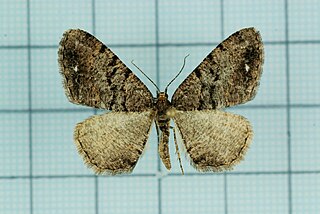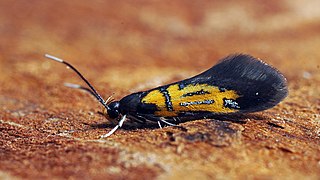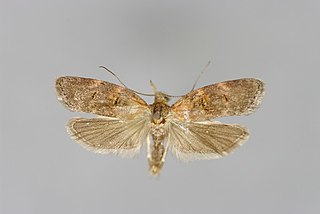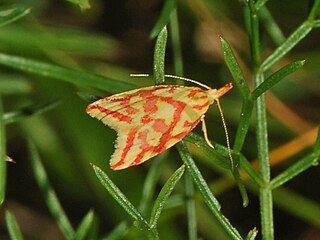Related Research Articles

The Coleophoridae are a family of small moths, belonging to the huge superfamily Gelechioidea. Collectively known as case-bearers, casebearing moths or case moths, this family is represented on all continents, but the majority are found in temperate areas of the Northern Hemisphere. They are most common in the Palearctic, and rare in sub-Saharan Africa, South America, and Australia; consequently, they probably originated in northern Eurasia. They are relatively common in houses, they seek out moist areas to rest and procreate.

Acompsia is a genus of the twirler moth family (Gelechiidae). Though it has once been assigned to the proposed subfamily "Anacampsinae", it is generally placed in the Dichomeridinae. Some authors include Telephila here as a subgenus, while others prefer to keep it distinct as its relationships are fairly obscure.

Bryotropha is a genus of the twirler moth family (Gelechiidae). Among these, it is placed in the tribe Anomologini of subfamily Gelechiinae; the tribe was formerly considered a distinct subfamily Anomologinae.
Ephysteris is a genus of the twirler moth family (Gelechiidae). Among these, it is assigned to tribe Gnorimoschemini of the subfamily Gelechiinae. Even though it is a rather diverse and widespread group, most of these small and inconspicuous moths were overlooked by scientists until the early 20th century. Almost 90 species are known today but new ones are still being discovered.

Scythropia crataegella, the hawthorn moth, is a species of moth in the monotypic genus Scythropia. It is found in western Eurasia.

Parectropis is a genus in the geometer moth family (Geometridae). A small Old World genus, it contains only a good dozen species altogether, though new ones are still being discovered. Only one species is found in Europe; most others live in Asia though some occur in Africa.

Haplotinea is a very small genus of fungus moths. Its subfamily among the fungus moths is disputed – many assign it to the Myrmecozelinae, but other authors have placed it in subfamily Nemapogoninae or Perissomasticinae. In all, its relationships are barely better resolved at present than those of the many Tineidae incertae sedis.

Nemaxera is a genus of the fungus moth family, Tineidae. Therein, it belongs to the subfamily Nemapogoninae. The genus is considered monotypic, with the single species Nemaxera betulinella placed here.

Monopis is a genus of the fungus moth family, Tineidae. Therein, it belongs to the nominate subfamily, Tineinae.

Esperia is a genus of the concealer moth family (Oecophoridae). Among these, it belongs to subfamily Oecophorinae. Most authors include Dasycera here, though approaches that generally follow a "splitting" approach sometimes do not.

Crassa is a genus of the concealer moth family (Oecophoridae). Among these, it belongs to subfamily Oecophorinae. The genus name Tichonia, established by J. Hübner in 1825, was frequently misapplied to these moths by earlier authors. But as the type species of Hübner's genus is the greenweed flat-body moth – originally described as Tinea atomella, but nowadays called Agonopterix atomella –, Tichonia is actually a junior synonym of Agonopterix. That genus does belong to the same superfamily as Crassa, but is placed in the concealer moth subfamily Depressariinae which is sometimes treated as distinct family.

Schiffermuelleria is a genus of gelechioid moths. It is placed in the subfamily Oecophorinae of family Oecophoridae. The genus is treated as monotypic, with the single species Schiffermuelleria schaefferella placed here. As such, its distinctness from the closely related genus Borkhausenia – where S. schaefferella was often placed in the past – is open to debate.

Scythris is a genus of gelechioid moths. It is the type genus of the flower moth family, which is sometimes included as a subfamily in the Xyloryctidae, or together with these merged into the Oecophoridae. The genus was erected by Jacob Hübner in 1825.

Diplodoma is a small genus of the bagworm moth family, Psychidae. Therein, it belongs to the Taleporiinae. Some authors consider Diplodoma a junior synonym of Narycia, but this is not widely accepted.
Scardia is a genus of the fungus moth family (Tineidae). Therein, it belongs to the subfamily Scardiinae, of which it is the type genus. Several of the species placed here in earlier times have been moved to other genera of the subfamily, e.g. Amorophaga, Montescardia, and Morophaga.

Tinea is a genus of the fungus moth family, Tineidae. Therein, it belongs to the subfamily Tineinae. As evident by its name, it is the type genus of its subfamily and family. Established as one of the first subgroups of "Phalaena", it used to contain many species of Tineidae that are nowadays placed in other genera, as well as a few moths nowadays placed elsewhere.

Semioscopis is a moth genus of the superfamily Gelechioidea. It is placed in the subfamily Depressariinae.

Anchinia is a genus of gelechioid moths.

Hypercallia is a genus of gelechioid moths.

Levipalpus is a moth genus of the superfamily Gelechioidea. It is placed in the family Depressariidae, which is often – particularly in older treatments – considered a subfamily of the Oecophoridae or included in the Elachistidae.
References
- Fauna Europaea (FE) (2009): Fuchsia [ dead link ]. Version 2.1, 2009-DEC-22. Retrieved 2012-JAN-27.
- Pitkin, Brian & Jenkins, Paul (2004): Butterflies and Moths of the World, Generic Names and their Type-species – Fuchsia. Version of 2004-NOV-05. Retrieved 2012-JAN-27.
- Savela, Markku (2001): Markku Savela's Lepidoptera and some other life forms – Fuchsia. Version of 2001-NOV-08. Retrieved 2012-JAN-27.